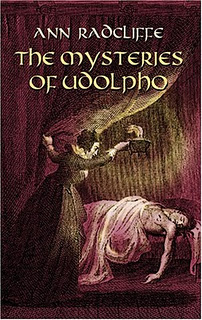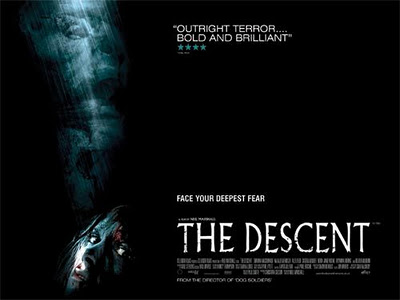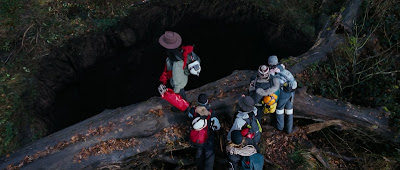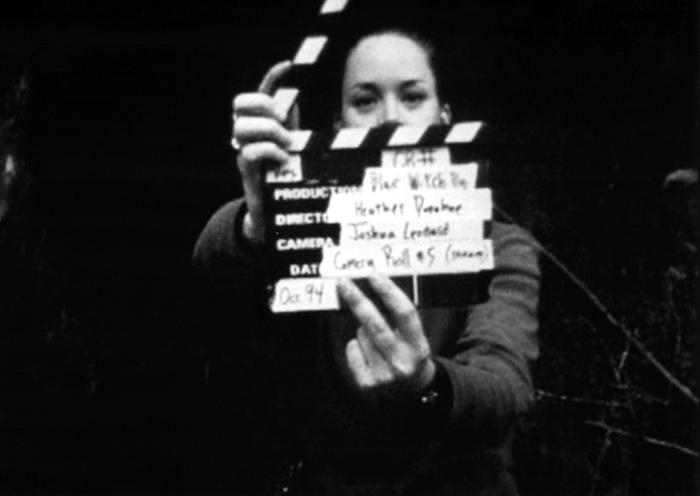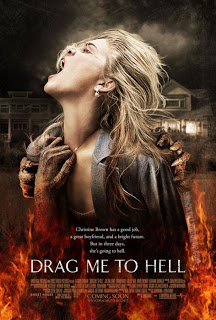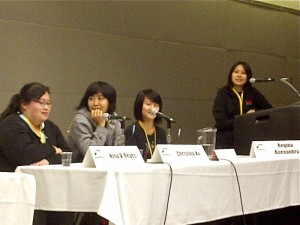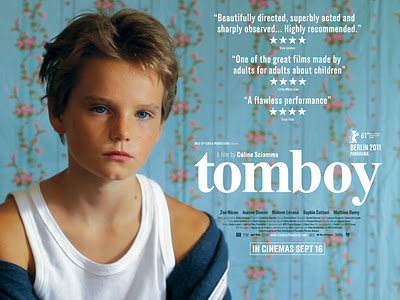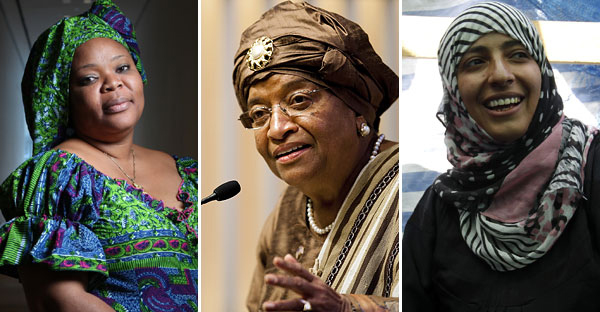Category: Uncategorized
The Madwoman’s Journey from the Attic into the Television – The Female Gothic Novel and its Influence on Modern Horror Films
 |
| The Mysteries of Udolpho, the first female gothic novel |
The very words “Gothic heroine” immediately conjure up a wealth of images for the modern reader: a young, attractive woman (virginity required) running in terror through an old, dark, crumbling mansion in the middle of nowhere, from either a psychotic man or a supernatural demon. She is always terminally helpless and more than a bit screechy, but is inevitably “saved” by the good guy/future husband in the nick of time.
Described in such a way, it’s easy to see why scholars have speculated that the “female gothic” novel is what gave rise to both the modern horror film and the modern romance novel. While the gothic form itself is attributed to Walpole, who collected all the possible tropes of the narrative and populated his “Castle of Otranto” with them, Anne Radcliffe is credited with popularizing the form. At the end of the 18thcentury, Radcliffe employed a female heroine as the protagonist of her novel, giving birth to what Ellen Moers later described and defined as the “female gothic,” which is considered a subgenre of Gothic literature. Novels, and gothic novels in particular, were consumed and written primarily by women during this time period, which made them a reviled form of fiction, generally depicted as the source of problems such as women’s vapidness, hysteria, nervous disorders and such. Twentieth century, however, saw scholars like Gilber, Gubar, and Moers starting to deconstruct the gothic form, which emerged as a unique battleground for the metaphoric struggle between women and the patriarchal structures/institutions that confined and limited them.
In their landmark study, “Madwoman in the Attic,” Gilbert and Gubar embraced the figure of Bertha Mason (the insane, ghostlike previous wife of Jane Eyre’s hero, Mr. Rochester, whom he has locked up inside the attic…apparently for her own good and out of the goodness of his heart!) as somewhat of an alternate literary heroine, and started to analyze exactly what was at work in the common themes found in the literature that women were writing during that time period. As women attempted to write themselves into the purely patriarchal forms of literature that they had grown up reading, they faced the limits of the representation of women in heroic roles. So the gothic heroine emerged as somewhat of a compromise: a heroine who is perpetually endangered and perpetually courageous in the face of that danger. This is the precursor of the modern horror movie heroine who, against all logic, insists on checking out that pesky sound in the middle of the night or following the creepy voices outside of her room. In the female gothic, the haunted castle emerges as a prison that the woman cannot escape, where she’s often being held against her wishes. Given this subtext, it’s easy to see why the castle was commonly used as a metaphor for patriarchal institutions, where the domestic sphere to which women were socially confined became a stifling prison that drove them insane.
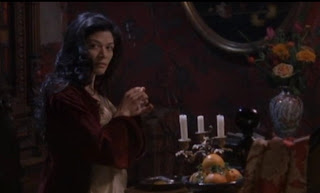 |
| Bertha Mason, the original Madwoman in the Attic, from the 2006 “Jane Eyre.” |
Ellen Moers further identified the two concerns of the gothic novel which deal with sexuality and child birth in the form of metaphors, where women are constantly confronted with the threats of living in a patriarchy disguised as the supernatural. It is noteworthy that while male writers of the time were tackling subjects like rape and sexual assault head on, the women were using complicated metaphors to confront these issues I would argue that for the male writer, given the distance they already have and maintain from these topics, it was easy to tell the story of the assault happening to an Other, where the assault is experienced by someone other than the male hero that the writer and the readers identified with. For women, however, there are different things at stake. Primarily, they were not allowed to write about sexuality in a straight-forward manner in a time when just the act of writing had male writers of the day calling these women tradeswoman, the implication being that they were not much better than prostitutes. Secondly, and perhaps more importantly, women, for whom these things were a real concern (within and without marriage), needed to cultivate the distance that male writers already had from these subjects, and they did so by wrapping the horrors in layers of metaphor.
In order to understand exactly how the gothic formula works almost as feminist deconstruction, it’s important to understand the gothic heroine and her unique struggles. It’s been said that the act of creating a work with a female heroine alone is feminist because it recognizes that women can exist in important stories without needing to be part of a man’s. The female gothic, however, goes a step further in portraying the dangers of confining women to the domestic sphere, confining them to enforced social roles, and the dangers of the kind of insanity that emerges from the kind of isolation and limitations.
The gothic heroine is almost always isolated, and isolated from female companionship in particular. The usual formula (which Jane Austen later deconstructed/parodied in her “Northanger Abbey”) has the mother of the heroine die either giving birth to the heroine or shortly afterward, ensuring that the heroine is an only child. The heroine is brought up under her father’s care, who is a benevolent, loving male figure who dies promptly when the heroine reaches maturity. At this point, the heroine comes under the guardianship of a sinister male figure and is removed to his castle, to which she is confined. This is the pattern Radcliffe’s “Mysteries of Udolpho” follows, and it’s one that’s still common to see in gothic slanted horror movies like “Skeleton Key,” wherein the heroine’s mother left when she was young, she was close to her father, and the father’s death is what indirectly leads to her coming to live in her own gothic manor with its secrets. One of the things that Gilbert and Gubar address in their book is the woman author’s lack of connection to female writers because the literary canon is made up of male writers alone. So perhaps the birth of a heroine who knows she had a mother, but one that she’s unable to connect to is a reflection of the gothic writer’s lack of connection to her own literary foremothers.
Once locked inside this castle, by the men or circumstances, the heroine usually goes exploring, and often finds secrets having to do with the death/imprisonment/insanity of another woman. It is worth noting that her primary motivation often has to do with saving herself by trying to figure out what became of the woman who occupied this place before her. Essentially, this can be seen as her search for female companionship/connection. This is where the other big theme of the gothic emerges: the theme of insanity and fragmentation of self. The heroine, surrounded by men who wish to keep the fate of the women before her secret, comes to doubt her own sanity as everyone around her questions her. So the entire structure of the gothic became an elaborate metaphor for the perils of women living in confined spaces and being controlled by men. Daphne du Maurier’s “Rebecca,” which has famously been referred to as a love story, features a young woman marrying much above her social class and moving into another mansion with its own secrets. Du Maurier herself said that the book was about the imbalance of power within a marriage. Written to reexamine the figure of the insane wife locked away in the attic, “Rebecca” recreates this figure into an alluring, haunting portrait of a woman whose death and whose life echoes in every corner of the house. Unlike the Bertha Mason of “Jane Eyre,” who needs to be hidden and never talked about, Rebecca is all anyone in Manderley talks about, until the unnamed narrator finds herself falling under her spell, too. Even though Rebecca is a much more alluring take on the Madwoman concept, she has one thing in common with her precursor, which is that she, like Bertha Mason, challenges patriarchal notions of what a proper woman should be like.
 |
| The second Mrs. de Winter being forced to confront the ghost of Rebecca by Mrs. Danvers in Hitchcock’s 1938 “Rebecca” |
Gilbert and Gubar offer the following analysis of the Madwoman figure and her prominent appearances in 19th century women’s literature:
We will find that this madwoman emerges over and over again from the mirrors women writers hold up both to their own natures and to their own visions of nature. Even the most apparently conservative and decorous women writers obsessively create fiercely independent characters who seek to destroy all the patriarchal structures which both their authors and their authors’ heroines seem to accept as inevitable. Of course, by projecting their rebellious impulses not into their heroines but into mad or monstrous women (who are suitably punished in the course of the novel or poem), female authors dramatize their own self-division, their desire both to accept the structures of patriarchal society and to reject them. What this means, however, is that the madwoman in literature by women is not merely, as she might be in male literature, an antagonist or foil to the heroine. Rather, she is usually in some sense the author’s double, an image of her own anxiety and rage.
The idea of doubles remains a major theme in gothic themed horror films of today. The heroine’s doppelganger is often the quest object of her journey, where salvation often comes by discovering the story of this woman who can be seen as a darker or more otherworldy version of the heroine. Gothic stories have, arguably, at their center the idea of women trying to form bonds with each other, while resisting the influence of the men around them. Horror remains, to this day, one of the very few genres where it’s more common to find a female heroine than a male protagonist, and it’s no wonder that it’s primarily consumed by women and considered to be the other major women’s genre, besides romance. It’s also a genre that often easily passes the Bechdel test because of the relationships it portrays between the women. Horror genre, however, seems to have split into two separate branches. There’s the gothic themed stories where women are at the center of them and the threat is supernatural/psychological, and there’s the torture/slasher horror where women mostly run for their lives. Admittedly, I am a lot more interested in the former kind, and will mostly be exploring how they’re the literary successors of the female gothic.
“Pan’s Labyrinth” is a classic gothic tale where the young heroine coming under the domain of a powerful and sinister male figure forms bonds with another woman and finds salvation in her own discoveries and the story of an exiled princess, who serves as both a double and the supernatural presence on the other side of the mirror. The mother, while a significant part of the story, is in no position to protect Ofelia, who is left under the rule of her step-father, as she discovers hidden passages and lost worlds in order to save herself.
As I mentioned before, the female gothic split into the genres of modern horror narratives and modern romance novel. Divorcing the romance plot of the gothic novel from the rest of it has arguably left us with narratives where the heroines are left to save themselves, with no strong and benevolent male figure coming to help them. However, I should mention that the gothic romance wasn’t as clear cut as the above quote makes it out to be. In a gender-reversed reflection of the Dark Heroine/Light Heroine dichotomy that male-centered narratives seem to be obsessed with, the gothic romance is the one major genre where the male characters are split off into their own versions of Madonna/Whore. The Shadow Male figure is the sinister, powerful man who rules over the heroine’s life but with no benevolent intentions towards her. She’s sometimes sexually attracted to this figure, but also fearful of him. While the man that she’s actually in love with is often powerless to defend her despite his desire to protect her.
In taking out this benevolent male figure, the modern horror leaves the heroines to their own discoveries. “The Skeleton Key” is an especially subversive example of these tropes. The heroine, isolated from her native element, comes to live inside the old manor presided over by a powerful yet sinister seeming woman. As noted before, the heroine of the movie, Caroline, has a very gothic background, but in a gender reversal of the usual tropes, she forms a bond with the powerless male figure residing inside the house, while coming to suspect the powerful Violet as his abuser. In converting the Shadow Male figure to a woman, the movie lets the men become the Other presence in the attic, who are silenced, ghost-like, and pushed into the background as the women fight their battle of wills in the foreground of the movie. Violet can, however, also be read as a more corporeal version of the Madwoman, the doppelganger who perhaps embodies the character’s more rebellious urges, while existing outside of Caroline as a force to be struggled against. The ending is especially interesting if we choose to read Violet as a metaphorical version of Caroline’s fragmented self.
“Silent Hill” is another movie that seems to get rid of the sinister male figure, populating its world entirely with powerful women with agendas and various motivations. Rose, the heroine of the movie, travels to a ghost town in an attempt to discover the cure to her daughter’s nightmares. Once inside the town, Rose is trapped inside a haunting alternate verse that seems to have enveloped the entire town. In order to escape the tainted reality of Silent Hill, Rose must discover the origins of the taint, and that leads her to discover the stories of various women who were responsible for the genesis of the new reality. This act of discovering the stories and secrets of the lives of women in the past seems to run through most gothic horror movies, in an echo of the attempts of the gothic writers who searched the past to find literary foremothers and of their heroines who attempted to decipher their own future by discovering the pasts of other women. This movie is especially relevant to gothic themes because the idea of fragmentation of selves is the foundation of the premise and leads to the genesis of Silent Hill as it currently exists, with two sets of doppelgangers.
There’s also “Beneath,” perhaps the most underappreciated horror movie of all time, that brings back the themes of “Rebecca” and “Jane Eyre” wonderfully by dealing with the theme of menacing husbands and women who live on even after their deaths. Its heroine, who is the sister of the Madwoman in the Attic figure of the movie (again, the theme of a darker self/mirror), comes back to the town where her sister died and gets pulled into a web of secrets and deceptions that lead her to have visions. She becomes obsessed with discovering exactly how her sister died, while the men around her doubt her sanity. The theme of the heroine’s sanity being doubted is probably the biggest common denominator in these. serves further to isolate the heroine, to push her to do things on her own for the fear that she will be labeled as insane. Historically, the fear of being mislabeled as insane has had a unique significance for women, many of whom were driven to brinks of insanity by what was referred to as “the rest cure.”
Charlotte Perkin Gilman’s “The Yellow Wallpaper” is a gothic themed look inside just such a madness, brought on by lack of mental stimulation. “The Ring,” while populated with more men than is common for these types of movies, still has at its center the idea of a woman deconstructing the story/life of another woman. Rachel’s search for answers is triggered by the death of a woman and it leads her to discover the lives of Anna and Samara, both of whom have elements of the Madwoman figure. Samara, in particular, is reminiscent of the “creeping, crawling” woman trapped behind the Yellow Wallpaper. Interestingly enough, Samara is kept isolated in a room with yellow wallpaper that Rachel is forced to tear off before she can uncover the truth behind Samara’s story.
The second aspect of the female gothic was identified by Ellen Moers as dealing with the fear of giving birth/creating life, and the modern birth horror genre definitely echoes the themes Moers identifies. My knowledge and viewing experience of this type of horror is not nearly as vast as my knowledge of the haunted house/insanity type of horror, but I will identify some movies that deal with this type of horror, in case someone else is interested in watching/analyzing some of these. According to Moers, Mary Shelley reinvented the female gothic with her “Frankenstein.” Shelley, unlike most women writing during that time period, who tended to be unmarried, had had experience with child birth. Moers’ essay here more fully explores how Shelley’s own experiences led to the creation of her monster, but it’s worth noting that Mary Shelley chose to make her protagonist and her monster both men in a step away from the female-centered gothic novels of years past. However, I am pleased that the modern birth horror tends to place women at its center, and perhaps, it’s more relevant to women’s reproductive rights issues today because a lot of it deals with women losing control of their bodies/identities/agency in the course of the pregnancy. “The Clinic” deals with several pregnant women trapped inside an unsanitary clinic, waking up to find that they’re no longer pregnant. The rest of the movie follows them as they attempt to find their babies and discover how they got there. One of the major themes, I would say, is the idea of women’s bodies and reproductive systems as commodities.
There’s the famous “Rosemary’s Baby” that perhaps better echoes Mary Shelley’s novel because the fear of the baby being a monster runs through the entire movie. Rosemary’s rising anxiety and fears for her baby as she discovers the existence of the cult and its plans are very in with keeping the Gothic heroine’s general mental state. “Blessed,” starring Heather Graham, is similar in its themes to “Rosemary’s Baby,” where the heroine is used as an incubator for a cult needing to bring about the birth of a demonic child. The 2009, “Grace,” deals with a mother who decides to carry her baby to term despite the heartbeat having stopped following a car crash, and when the time comes, the baby is miraculously born alive. As the movie progresses, it becomes clear that there’s something wrong with the baby, and our heroine has created a monster. The recent “Splice” deals with a female scientist who creates a new species by combining her own DNA with the DNA of various animals.
While the first subgenre of gothic horror deals with the metaphor of women being trapped inside patriarchal institutions and being forced by them to question their own sense of reality, the birth horror genre, arguably, deals with and plays into women’s fear of patriarchal control over their bodies and the lack of agency that comes with that control. The fate of the birth horror heroine, however, is often worse than the earlier gothic heroines, who, while often up against great odds, are fighting a monster/institution that exists outside of themselves. In the birth horror genre, the woman is fighting a more personal and internal battle. Women today still struggle to control the fate of their own bodies in a largely patriarchal world.
Gilbert and Gubar, too, identify a fear of creation in their study, specifically, the fear of creating a literary text in a canon that’s made up of patriarchal and male-centered texts. The female author learns to see the act of creation as a male one because she’s learned to see herself only in passive roles from the literature she’s consumed. Gilbert and Gubar refer to this as “anxiety of authorship,” and since the gothic heroine is often an artist of some kind (in fact, Jane Austen, in her parody of the form, goes out of her way to assure the readers that her heroine, Catherine Morland is not at all inclined to the arts and furthermore, is really bad at them) this anxiety of authorship can always be called an anxiety of creation. And the birth horror movies that do not fit under Moers’ definition of the birth horror story with the fear of creating a monster certainly deal with the anxiety of giving birth and creating life. Returning to the mental health side of it, since insanity and anxiety remain major themes of any sort of a gothic story, post-partum depression is another side effect of living in a patriarchal society that expects women to be mothers, and most women get conditioned into thinking that that is what they want for themselves. Given the cultural subtext, motherhood can become just another patriarchally enforced institution, one that patriarchy values over most other social obligations/interests of a woman. Birth horror genre is the perfect medium to deconstruct some of those expectations and institutions.
“To be trained in renunciation is almost necessarily to be trained to ill health, since the human animal’s first and strongest urge is to his/her own survival, pleasure, assertion,” write Gilbert and Gubar. Studies have linked mental illnesses commonly found in women such as agoraphobia, anxiety disorders, eating disorders to the effects of patriarchal conditioning and socialization. Girls get conditioned to be pleasing at the cost of disowning their own pleasures, they learn to place a high value on physical beauty, which is fleeting, and they learn to see themselves through the male gaze from early on, whether it’s through reading literature in the 19th century or through media and advertising portrayals of themselves in the current one. Women learn to see themselves as men see them while struggling with their own conflicting points of view of themselves and this fear of conflicting with the dominant paradigm enforces a culture of silence and repression that locks women into their own metaphorical castles of terror. This may be why horror films continue to resonate with modern women. Many horror films today take place in suburban homes, which can be just as stifling as the castles in the gothic novels. Films may no longer need dark and crumbling castles to be scary, but the ideas those castles represented are still alive in the horror genre. As long as women’s stories and voices are suppressed, the horror genre will continue to be the metaphorical battleground for women to fight against the patriarchal institutions that dominate their lives.
—
Note: While Gilbert and Gubar introduced ideas that have been used to analyze gothic fiction, they did not specifically deconstruct the genre itself. For further reading on that, I recommend “Gilbert and Gubar’s The Madwoman in the Attic after Thirty Years,” which explores the effects of their study on feminist lit critique. There’s an essay within that collection that specifically deals with the gothic form by Carol Margaret Davison entitled “Ghosts in the Attic.”
Horror Week 2011: The Descent
When I first heard of The Descent, around the time of its 2006 theatrical release, it was described to me as “a movie about a bunch of lesbians who go into a cave and there are monsters.”
Horror Week 2011: The Blair Witch Project
 |
| The Blair Witch Project (1999) |
Viewers might hope that with its unconventional approach, shoestring budget, and status as the first blockbuster powered by Internet buzz, The Blair Witch Project could offer horror fans something they haven’t seen before, specifically in terms of how women are represented. At first, the flick looks promising because it centers on a female lead in a position of authority. While it’s arguable whether The Blair Witch Project’s through-the-viewfinder conceit is actually innovative (cinephiles like to point to the correlations between Blair Witch and Man Bites Dog and Cannibal Holocaust), it’s safe to say that—in 1999, at least—no films with this particular conceit had enjoyed such widespread popularity. The presence of this conceit might account for the film’s success, coming as it did in the watershed era of reality television. Its lo-fi, DYI qualities lend the film a realism that at that time felt new and potentially persuasive. While the ensuing years have brought us further variations on the motif—Cloverfield, Paranormal Activity, and Super 8, among others—it’s also become much easier to see how The Blair Witch Project, for all its putative realism, renders unduly harsh judgments on its female lead.
Horror Week 2011: Drag Me to Hell
This review, written by Stephanie Rogers, was originally published in June 2009.
But, I ask you, can a film that sacrifices a goat and a kitten really be taking itself so seriously?
 Everything that exists in this movie is a stereotype: the skinny blonde who used to be fat and now refuses to eat carbs, the skinny blonde’s self-hatred and rejection of her farm-girl roots, the rich boyfriend who will undoubtedly help her escape it all, his rich and consequently vapid, overbearing parents who want their son to marry a nice upper-class girl, the patriarchal workplace where the skinny blonde gets sent for sandwiches by her male coworkers, the jerk who sells out a coworker in order to get promoted, the brown-skinned psychics who hold hands around a table and chant in an attempt to invoke The Evil Spirit, the gypsy, obviously, and not least importantly, the fucking goat sacrifice.
Everything that exists in this movie is a stereotype: the skinny blonde who used to be fat and now refuses to eat carbs, the skinny blonde’s self-hatred and rejection of her farm-girl roots, the rich boyfriend who will undoubtedly help her escape it all, his rich and consequently vapid, overbearing parents who want their son to marry a nice upper-class girl, the patriarchal workplace where the skinny blonde gets sent for sandwiches by her male coworkers, the jerk who sells out a coworker in order to get promoted, the brown-skinned psychics who hold hands around a table and chant in an attempt to invoke The Evil Spirit, the gypsy, obviously, and not least importantly, the fucking goat sacrifice.
The point is: it’s hard to play the I-hated-this-movie-because-of-the-blah-blah-“insert offensive stereotype”-game, when the film unapologetically turns everyone into a caricature.
Drag Me To Hell is about a young woman, Christine (played by Alison Lohman), who makes a questionable decision in an effort to get promoted at the bank where she works. She refuses to give a third extension on a woman’s mortgage loan, and in doing so, the woman, Mrs. Sylvia Ganush (played by Lorna Raver), could potentially lose her home. The twist? Christine could’ve given her the extension. But she chose not to. Instead, Christine wanted to prove to her boss that she’s a tough, hard-nosed, business savvy go-getter, and therefore certainly more qualified than her ass-kissing male coworker (who she’s in the process of, ahem, training) to take over the assistant manager position.
Then, as luck would have it, all hell breaks loose.
 For the next hour and a half, these women go all testosterone and maniacally kick each other’s asses. This isn’t an Obsessed-type ass-kicking, where Beyonce Knowles beats the crap out of Ali Larter over, gasp, a man! and where all that girl-on-girl action plays like late-night Cinemax porn for all the men in the house. (Read Sady Doyle’s excellent review of it here). No, this is strictly about two women, one old, gross, and dead, the other young, gorgeous, and alive, trying to settle a score. Christine wants to live, dammit! And Mrs. Ganush wants to teach Christine a lesson for betraying her in favor of corporate success!
For the next hour and a half, these women go all testosterone and maniacally kick each other’s asses. This isn’t an Obsessed-type ass-kicking, where Beyonce Knowles beats the crap out of Ali Larter over, gasp, a man! and where all that girl-on-girl action plays like late-night Cinemax porn for all the men in the house. (Read Sady Doyle’s excellent review of it here). No, this is strictly about two women, one old, gross, and dead, the other young, gorgeous, and alive, trying to settle a score. Christine wants to live, dammit! And Mrs. Ganush wants to teach Christine a lesson for betraying her in favor of corporate success!
I vacillated between these two women throughout the movie, hating one and loving the other. After all, Christine merely made a decision to advance her career, a decision that a man in her position wouldn’t have had to face (because he wouldn’t have been expected to prove his lack of “weakness”). If her male coworker had given the mortgage extension, I doubt it would’ve necessarily been seen as a weak move. And even though Christine made a convincing argument to her boss for why the bank could help the woman (demonstrating her business awareness in the process), her boss still desired to see Christine lay the smack-down on Grandma Ganush. I sympathized with her predicament on one hand, and on the other, I found her extremely unlikable and ultimately “weak” for denying the loan. (Check out the review at Feministing for another take on this.)
Mrs. Ganush, though, isn’t your usual villain. She’s a poor grandmother, who fears losing her home. She literally gets down on her knees and begs Christine for the extension. Sure, she hacks snot into a hankie and gratuitously removes her teeth here and there, but hey, she’s a grandma, what’s not to love? Other than, you know, evil.
 I love that this movie is about two women who are both arguably unlikeable to the point where you hope they either both win or both die. (The last time I remember feeling that way while watching a movie was probably during some male-driven cop/gangster drama. Donnie Brasco? American Gangster? Goodfellas? Do women even exist in those movies?) Everyone else is a sidekick, including the doe-eyed boyfriend (played by Justin Long), who basically plays the stand-by-your-(wo)man character usually reserved for women in every other movie ever made in the history of movies, give or take, like, three.
I love that this movie is about two women who are both arguably unlikeable to the point where you hope they either both win or both die. (The last time I remember feeling that way while watching a movie was probably during some male-driven cop/gangster drama. Donnie Brasco? American Gangster? Goodfellas? Do women even exist in those movies?) Everyone else is a sidekick, including the doe-eyed boyfriend (played by Justin Long), who basically plays the stand-by-your-(wo)man character usually reserved for women in every other movie ever made in the history of movies, give or take, like, three.
But at the same time, one could certainly argue that Christine’s unwillingness to help Mrs. Ganush, which results in Christine spending the next three days of her life desperately trying not to be dragged to hell, plays as a lesson to women: you can’t get ahead, regardless, so just stop trying. (Dana Stevens provides an analysis on Slate regarding this double-edged-sword dilemma that Christina finds herself in.)
 Some have also argued that Drag Me To Hell exists in the same vein as the Saw films: it’s nothing but torture porn and obviously antifeminist. Yes, it’s gory, with lots of nasty stuff going in and out of mouths (Freud?), but the villain gets her share, and Christine hardly compares to the traditional heroine of lesser gore-fests: for one, she’s strong, much stronger than the horror-girls who can’t seem to walk without falling down in their miniskirts, and for the most part, she makes life-or-death decisions on her own, growing stronger and more adept as she faces the consequences of those decisions.
Some have also argued that Drag Me To Hell exists in the same vein as the Saw films: it’s nothing but torture porn and obviously antifeminist. Yes, it’s gory, with lots of nasty stuff going in and out of mouths (Freud?), but the villain gets her share, and Christine hardly compares to the traditional heroine of lesser gore-fests: for one, she’s strong, much stronger than the horror-girls who can’t seem to walk without falling down in their miniskirts, and for the most part, she makes life-or-death decisions on her own, growing stronger and more adept as she faces the consequences of those decisions.
Perhaps most importantly, Christine isn’t captured by some sociopathic male serial killer and helplessly tortured in a middle-of-nowhere shed for five days. She trades blows with her attacker, and at one point, in pursuit of Mrs. Ganush, she even states that she’s about to go, “Get some.” (Ha.)
I personally read the film as an attempt to uphold the qualities our society traditionally categorizes as “feminine” characteristics: compassion, understanding, consideration, etc. I’m not suggesting that men don’t also exhibit these qualities, but when they do, they’re often considered weak and unmanly, especially when portrayed on-screen, which is demonstrated quite effectively when Christine confronts her male coworker about his attempts to sabotage her career; he bursts into tears in a deliberately pathetic played-for-laughs diner scene.
But it’s only when Christine rejects these qualities in herself (the sympathetic emotions she initially feels toward Mrs. Ganush), and consciously coaxes herself into adopting hard-nosed, traditionally “masculine” characteristics (which her male boss rewards her for), that she’s ultimately punished—and by another woman, no less. The question remains, though, is she punished for being a domineering corporate bitch, or is she punished for rejecting her initial response to help out? Regardless of the answer, the film makes a direct commentary on the can’t-win plight of women in the workplace, and, newsflash: it still ain’t pretty.
Watch the trailer here.
Horror Week 2011: The Silence of the Lambs
 |
| The Silence of the Lambs (1991) |
Horror Week 2011: Sleepaway Camp
 |
| Sleepaway Camp (1983) |
But Angela’s not deceiving everybody because she’s a trans* person. She’s deceiving everybody because she’s a (fictional) trans* person created by cissexual filmmakers. As Drakyn points out, the trans* person who’s “fooling” us on purpose is a myth we cissexuals invented. Why? Because we are so focused on our own narrow experience of gender that we can’t imagine anything outside it. We take it for granted that everyone’s gender matches the sex they were born with. With this assumption in place, the only logical reason to change one’s gender is to lie to somebody.
Director Spotlight: Deepa Mehta
 |
| Deepa Mehta |
| Heaven on Earth (2008) |
When Chand (played by Bollywood superstar Preity Zinta) arrives in Brampton, Ontario to meet her new husband, she leaves behind a loving family and supportive community. Now, in a new country, she finds herself living in a modest suburban home with seven other people and two part-time tenants. Inside the home, she is at the mercy of her husband’s temper, and her mother-in-law’s controlling behaviour.
After a magic root fails to transform her husband into a kind and loving man, Chand takes refuge in a familiar Indian folk tale featuring a King Cobra.
Watch the trailer:
 |
| Water (2005) |
In 1938, Gandhi’s party is making inroads in women’s rights. Chuyia, a child already married but living with her parents, becomes a widow. By tradition, she is unceremoniously left at a bare and impoverished widows’ ashram, beside the Ganges during monsoon season. The ashram’s leader pimps out Kalyani, a young and beautiful widow, for household funds. Narayan, a follower of Gandhi, falls in love with her. Can she break with tradition and religious teaching to marry him? The ashram’s moral center is Shakuntala, deeply religious but conflicted about her fate. Can she protect Kalyani or Chuyia? Amid all this water, is rebirth possible or does tradition drown all?
Watch the trailer:
 |
| Bollywood/Hollywood (2002) |
After Rahul’s white pop-star fiancée dies in a bizarre levitation accident his mother insists he find another girl as soon as possible, preferably a Hindi one. As she backs this up by postponing his sister’s wedding until he does so, he feels forced to act, the more so as he knows his sister is pregnant. But it’s a pretty tall order for an Indian living in Ontario, so when he meets striking escort Sunita who can ‘be whatever you want me to be’ he hatches a scheme to pass her off as his new betrothed. Things get complicated when his family start to take to her and he realises his own feelings are becoming rather stronger than that.
Watch the trailer:
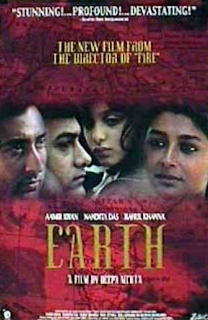 |
| Earth (1998) |
Earth is the second film in Mehta’s Elements Trilogy. The film seems to have won only a single award, and is based on Bapsi Sidhwa’s novel, Cracking India. Released in India as 1947: Earth, the film chronicles the division of India and Pakistan. From a plot summary on IMDb:
This story revolves around a few families of diverse religious backgrounds, namely, Muslim, Hindu, Sikh, and Parsi, located in Lahore, British India. While the Parsi family, a known minority in present day India, are prosperous, the rest of the families are shown as struggling to make a livelihood. Things change for the worse during 1947, the time the British decide to grant independence to India, and that’s when law and order break down, and chaos, anarchy, and destruction take over, resulting in millions of deaths, and millions more rendered homeless and destitute. In this particular instance, Shanta is a Hindu maid with the Sethna (Parsi) family, who is in love with Hassan, a Muslim, while Dil Navaz loves Shanta, and wants her to be his wife, she prefers Hassan over him. This decision will have disastrous effects on everyone concerned, including the ones involved in smuggling Hindus across the border into India.
Watch the trailer:
 |
| Fire (1996) |
Fire is the first film to confront lesbianism in a culture adamantly denying such a love could ever exist. Shabana Azmi shines as Radha Kapur in this taboo-breaking portrayal of contemporary India and the hidden desires that threaten to defy traditional expectations. In a barren, arranged marriage to an amateur swami who seeks enlightenment through celibacy. Radha’s life takes an irresistible turn when her beautiful young sister-in-law seeks to free herself from the confines of her own loveless marriage and into the supple embrace of Radha.
Watch the trailer:
Mehta’s films not mentioned here include Sam & Me, Camilla, The Republic of Love, and more.
In ‘Women, War & Peace’s ‘I Came to Testify’ Brave Bosnian Women Speak Out About Surviving Rape as a Weapon of War
“Their testimonies would embody the experience of hundreds of women held captive in Foca.”
 In Foca, half the residents, 20,000 Muslims were just gone. All 14 mosques were destroyed. Evidence in Foca showed that a campaign could be built to prove that a systematic, organized campaign of rape had been “used as an instrument of terror.” While the UN estimated 20,000 women raped in Bosnia, others say it was more like 50,000.
In Foca, half the residents, 20,000 Muslims were just gone. All 14 mosques were destroyed. Evidence in Foca showed that a campaign could be built to prove that a systematic, organized campaign of rape had been “used as an instrument of terror.” While the UN estimated 20,000 women raped in Bosnia, others say it was more like 50,000.
“Rape was used not only for the immediate impact on women but for the long-term destruction on the soul of the community.”
“Rape is the worst form of humiliation for any woman. But that was the goal: to kill a woman’s dignity.”
“…The people who came and testified were able to maintain their dignity and they didn’t let the perpetrators take their humanity away from them. So yes in one sense they were victims. But in another sense, they were the strong ones. They survived.”
“Looking at pictures of Nuremberg, it’s mostly men…women aren’t given a place at the table, even as a witness…”
“War criminals wouldn’t be known & there would be no justice if witnesses didn’t testify…I was glad to be able to say what happened to me and to say who had done this to me & my people. I felt like I had fulfilled my duty. I came to look him in the face. I came to testify.”
Megan contributed reviews of The Girl with the Dragon Tattoo, The Girl Who Played with Fire, The Girl Who Kicked the Hornet’s Nest, Something Borrowed, !Women Art Revolution, The Kids Are All Right (for our 2011 Best Picture Nominee Review Series), The Reader (for our 2009 Best Picture Nominee Review Series), Game of Thrones and The Killing (for our Emmy Week 2011), as well as a piece for Mad Men Week called, “Is Mad Men the Most Feminist Show on TV?” She was the first writer featured as a Monthly Guest Contributor.
Guest Writer Wednesday: Geek Girl Con: Feminism, Race, and Geek Culture
Movie Preview: Tomboy
A French family with two daughters, 10-year-old Laure and 6-year-old Jeanne, moves to a new neighborhood during the summer holidays. With her Jean Seberg haircut and tomboy ways, Laure is immediately mistaken for a boy by the local kids and passes herself off as Michael. Filmmaker Céline Sciamma brings a light and charming touch to this drama of childhood gender confusion. Zoe Heran as Laure/Michael and Malonn Levanna as Jeanne are nothing less than brilliant. This is a relationship movie: relationships between children, and the even more complicated one between one’s heart and body.
3 Women Share 2011 Nobel Peace Prize
 |
| Leymah Gbowee, Ellen Johnson Sirleaf, and Tawakkul Karman share the 2011 Nobel Peace Prize |
After a week of protests I was detained by the security forces in the middle of the night. This was to become a defining moment in the Yemeni revolution: media outlets reported my detention and demonstrations erupted in most provinces of the country; they were organised by students, civil society activists and politicians. The pressure on the government was intense, and I was released after 36 hours in a women’s prison, where I was kept in chains.
